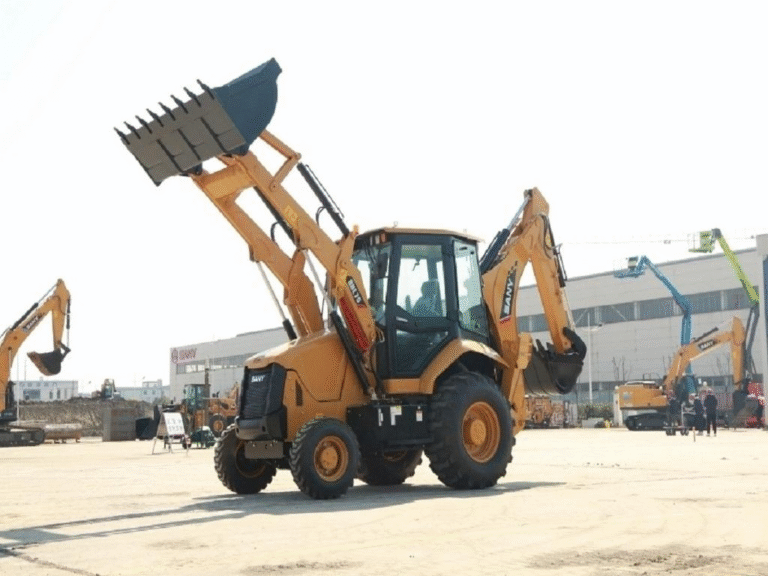A backhoe loader is among the most valuable machines on a building site. It is known for its strength and versatility, combining the force of a tractor, loader, and excavator into a single compact machine. Contractors frequently rely on this equipment to execute a variety of jobs swiftly and effectively. A backhoe loader can dig trenches, move goods, and break up concrete with ease. Its flexibility to move between activities without the use of several equipment makes it a popular choice for both large and small construction projects.
What Is a Backhoe Loader?
A backhoe loader is a multipurpose piece of heavy machinery that combines a tractor, a front loader, and a backhoe. The tractor provides mobility and stability, enabling the equipment to work in a variety of terrains. The front loader is mounted on the machine’s front end and is used to scoop, lift, and transport items such as gravel, sand, or garbage. The rear-mounted backhoe arm handles digging, trenching, and excavation duties. This multi-functional design makes the backhoe loader an excellent alternative for contractors who require flexibility on the jobsite. Its smaller size compared to larger excavators enables it to perform efficiently in restricted locations where larger equipment cannot.
What Are the Primary Uses of a Backhoe Loader?
Digging and Excavation Tasks
The backhoe attachment is primarily intended for digging, trenching, and excavation jobs. Contractors frequently use it to dig foundations, install utility lines, and prepare sites for landscaping. The adjustable arm gives accuracy and depth control, making it ideal for intricate digging in both home and commercial settings. Unlike bigger excavators, a backhoe loader can fit into smaller locations while still providing enough digging force. This makes it particularly beneficial in urban buildings, where space is restricted. Its capacity to dig properly while remaining stable leads to speedier project completion and minimizes the requirement for extra specialist equipment.
Loading and Material Handling
The front loader bucket provides the equipment with the strength for moving and carrying goods. It can scoop and swiftly carry dirt, gravel, sand, or demolition waste over the site. Contractors often use the loader to backfill ditches, level the ground, and disperse materials uniformly. This function improves workflow by minimizing manual labor and allowing employees to focus on other activities. With its powerful lifting capability, the loader can securely transport huge items, reducing the need for additional gear. The backhoe loader’s capacity to flip between digging and loading operations makes it an effective and useful piece of equipment for construction projects.

Demolition and Small Construction Jobs
Backhoe loaders are also often utilized in small-scale demolition and general building projects. The backhoe arm can break up concrete or asphalt, and accessories like hammers or augers increase its capabilities even more. The equipment provides both power and precision for ripping down smaller structures, prepping building sites, or placing posts. Its small size helps it to avoid impediments while delivering the power required to complete difficult jobs. Contractors value its capacity to handle both heavy-duty and delicate work without requiring numerous specialist equipment, making it an economical solution for smaller jobs.
Why Are Backhoe Loaders Essential in Construction Projects?
Versatility Across Job Sites
One of the main reasons backhoe loaders are essential is their versatility. They are capable of doing a broad variety of activities, including excavating, grading, lifting, and hauling. They can swiftly adjust to the demands of the project by switching between different attachments. This flexibility lowers downtime and boosts production, particularly in locations where several types of labor are required. A backhoe loader is versatile enough to handle road construction, building foundations, landscaping, and utility installation. Contractors like this versatility because it reduces the need to bring several machines to a single site, saving both time and costs.
Cost-Effectiveness and Efficiency
Backhoe loaders are an economical alternative for contractors that want maximum productivity from a single equipment. Instead of purchasing several excavators, loaders, and smaller equipment, businesses may rely on a single machine to accomplish many jobs. This lowers equipment costs, fuel usage, and maintenance charges. Furthermore, the machine’s capacity to accomplish tasks swiftly improves overall efficiency. Crews can complete jobs in less time, keeping projects on schedule and within budget. A backhoe loader allows smaller businesses to compete with larger contractors at a lower cost by delivering a strong gear that produces professional results without requiring a huge investment.
Compact Size and Mobility Benefits
Unlike bigger construction machines, a backhoe loader combines power and mobility. Its modest size enables it to function in tight spaces such as residential neighborhoods, city streets, and small task sites. It can readily go past barriers and reach locations where larger equipment cannot go. The machine’s mobility also allows for easy transportation from one location to another, eliminating project delays. Contractors benefit from its capacity to travel fast across rough terrain while being stable. This combination of power, agility, and compactness makes the backhoe loader a dependable choice for a wide range of construction applications.
Conclusion
A backhoe loader is an essential machine in modern construction due to its capacity to execute several tasks effectively. It can dig, load, break, and transfer materials with ease, making it ideal for tasks of any size. Contractors respect it for its adaptability, cost-effectiveness, and mobility, particularly when operating in areas where larger machinery cannot function. The backhoe loader saves money and increases production by combining the operations of a tractor, loader, and excavator. Its versatility guarantees that it remains one of the most often used pieces of equipment on building projects across the world.


